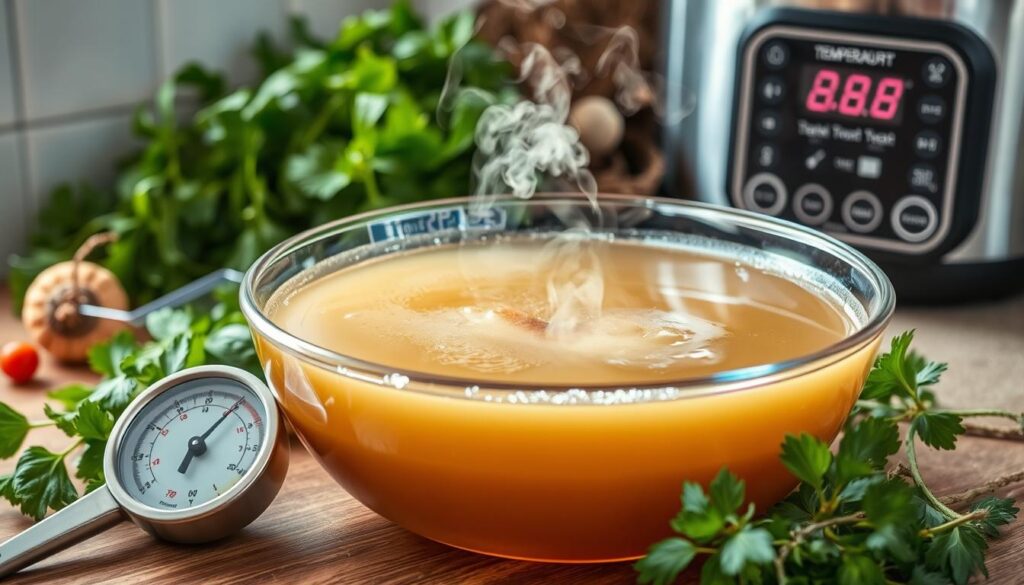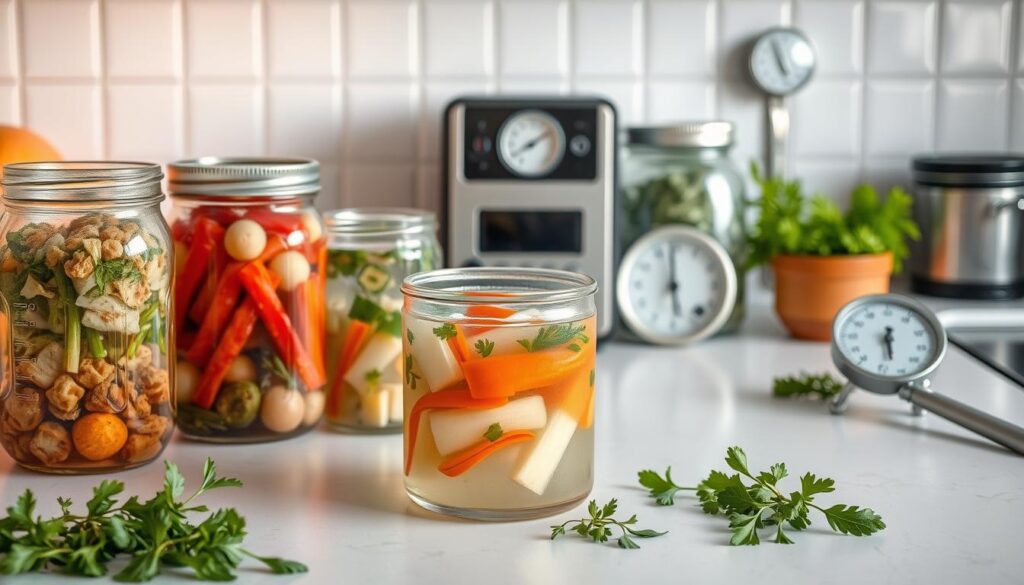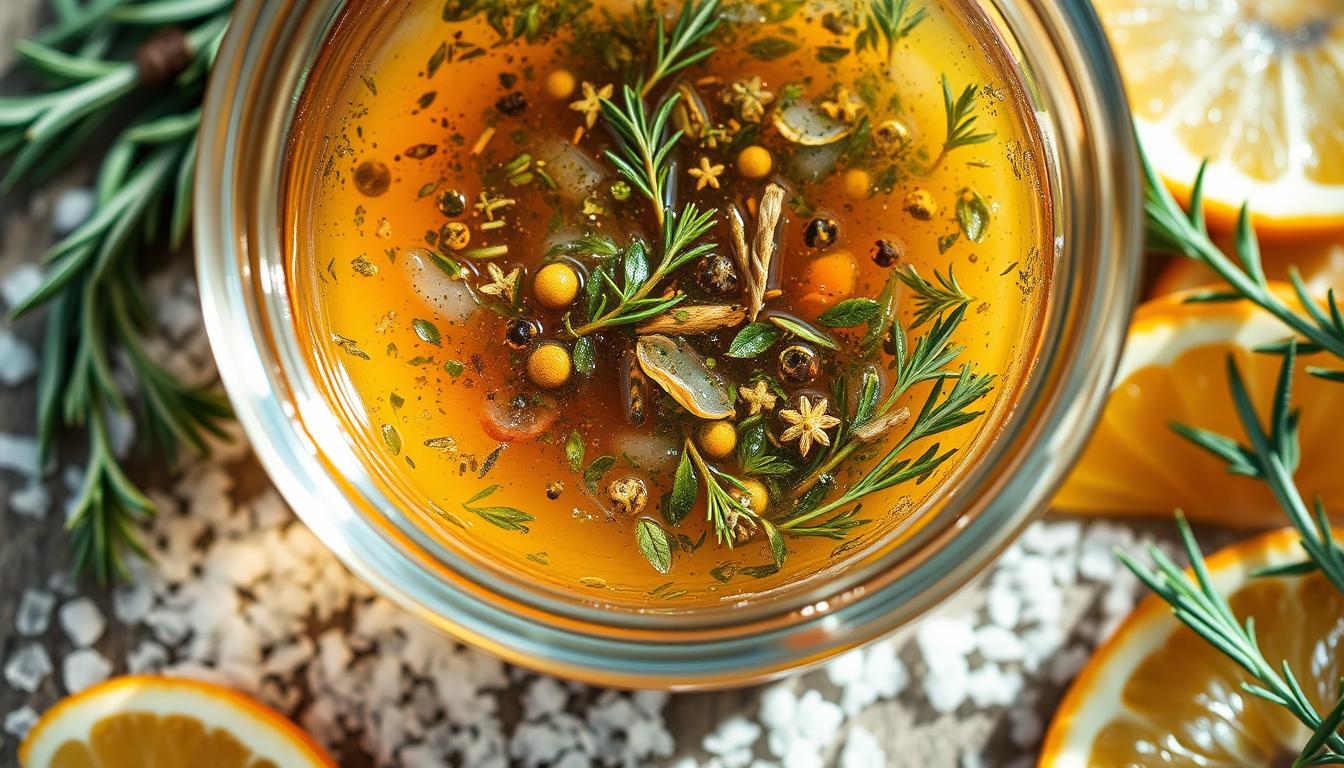As a passionate home cook, I’ve always been fascinated by the art of brine rest. This delicate process unlocks the true potential of your meats. It turns them into moist, flavorful masterpieces. Whether curing meats for long-term preservation or enhancing weeknight dinner, knowing the right brine rest time is key.
The sweet spot for brine rest is about 2 hours. This brief time lets salt and flavor compounds deeply penetrate the meat. It locks in moisture and adds an unparalleled depth of taste. It’s a balance of science and art in salting meats and meat preservation.
Over the years, I’ve tried many brining techniques. The 2-hour rest period always gives the best results. The brine’s higher salt and hot solution extract flavors quickly. This ensures every bite is a symphony of savory goodness.
Ready to elevate your cooking and unlock your meats’ potential? Let’s explore brine rest together. With patience and the right technique, you’ll create dishes that everyone will love. Get ready for juicy, flavorful rewards – the perfect brine rest is just around the corner.
Table of Contents
Understanding the Fundamentals of Brining
Brining changes the texture and taste of meats. It involves soaking meat in a saltwater mix. This makes the meat juicier and tender.
This method is key in making charcuterie and keeping food safe.
The Science Behind Salt Absorption
Salt works magic on meat’s proteins. When meat soaks in saltwater, its proteins change. This lets the meat hold more water, making it juicier and tastier.
How Brining Affects Meat Structure
Brining does more than add flavor. It also makes meat tender. The salt breaks down muscle fibers, making meat chewable.
This change helps the meat keep moisture while cooking.
Role of Temperature in Brining Process
Temperature is important in brining. It should be between 35°F and 40°F (1.7°C and 4.4°C). This keeps bacteria away, making the meat safe and lasting longer.
The salt in the brine also stops bacteria growth. This extends the meat’s shelf life.
Learning about brining’s science can improve your cooking. It’s great for making a juicy turkey or tender pork chops. Mastering brining can take your dishes to the next level.
The Perfect Brine Rest Duration
When curing meats, the brine rest time is key. It usually ranges from 30 minutes to 24 hours. This depends on the meat type and size.
For chicken breasts, a brine of 30 minutes to 4 hours works well. This ensures the meat stays juicy and flavorful. Remember to flip the chicken halfway through.
Larger meats, like turkey, need a longer brine. Up to 24 hours for every 5 pounds is best. This makes the turkey moist and full of flavor.
After brining, dry the meat and let it air dry in the fridge. This step makes the skin crispy. It also improves the meat’s flavor and texture.
| Meat Type | Recommended Brine Rest Duration | Key Benefits |
|---|---|---|
| Turkey | 24 hours for every 5 pounds | Ensures a moist, tender, and flavorful turkey |
| Venison | 2-4 hours | Tenderizes the lean meat and prevents dryness |
| Chicken Breasts | 30 minutes to 4 hours | Proper moisture and flavor infusion without oversalting the meat |
| Turkey Breast | 6 to 24 hours | Ensures a moist, tender, and flavorful turkey breast |
Knowing the right brine time for each meat unlocks great flavor. It’s all about mastering traditional curing methods.
Essential Components of an Effective Brine Solution
Salting Meats and Charcuterie Techniques start with a good brine solution. The key is the salt-to-water ratio. It’s vital for the brining process and keeping food safe.
Salt-to-Water Ratio Guidelines
A basic brine solution uses 6 tablespoons of Diamond Crystal kosher salt or 4.5 tablespoons of Morton’s kosher salt for every 4 cups of cold water. This mix helps the meat soak up just the right amount of salt. It boosts flavor and texture without making it too salty.
Optional Flavor Enhancers
You can also add optional flavor enhancers to your brine. Think sugar, herbs, spices, garlic, and onions. Some recipes call for apple juice, beer, or pickle juice for extra flavor.
Temperature Control Methods
Keeping the brine at the right temperature is key for Food Safety. Use cold water and refrigerate the meat while it’s brining. The correct temperature stops bacteria from growing and makes the brining safe and effective.
By focusing on the salt-to-water ratio, adding flavor enhancers, and controlling temperature, you’ll make a great brine solution. It will make your Salting Meats and Charcuterie Techniques juicy and flavorful. And it will keep your food safe.
Brine Rest: Key Steps for Maximum Results
To get the best from your brining, follow a few important steps. Make sure the meat is fully covered in the brine. Use a container like plastic, glass, or stainless steel to prevent any bad reactions. Keeping the temperature cool during the rest is key for Meat Preservation and Flavor Development.
After brining, dry the meat well before cooking. For a crispy skin, let it air dry in the fridge for a bit. This step highlights the Traditional Methods of meat prep. Don’t add more salt when cooking brined meat, as it can make it too salty.
| Meat Type | Brining Time | Dry Brining Time |
|---|---|---|
| Whole Fish | 1-3 hours | N/A |
| Fish Fillets | 10-30 minutes | N/A |
| Shrimp or Scallops | 15-30 minutes | N/A |
| Boneless Pork Chops | 30 minutes | 1 hour per pound |
| Whole Poultry | N/A | 1-2 days |
By sticking to these steps, you’ll get the most out of your brining. You’ll improve Meat Preservation, Flavor Development, and use Traditional Methods.
Different Meats, Different Resting Times
Brining times change based on the meat type. It’s key for the right texture, flavor, and safety in Curing Meats and charcuterie.
Poultry Brining Guidelines
Chicken breasts need 30 minutes to 4 hours in brine. Whole turkeys might need up to 24 hours. Adjust brining time based on meat size and thickness.
Too long in brine can make poultry too salty. This is especially true with high salt solutions.
Red Meat Brining Specifications
Pork loin does well with 3-4 hours in brine. Larger red meat cuts, like roasts, might need up to 12 hours. Watch the brining time to avoid too much salt.
This can harm Charcuterie Techniques and Food Safety.
Seafood Brining Requirements
Fish fillets only need 15-30 minutes in brine. Seafood is delicate, so longer brining can make it too salty.
These are general times. Adjust based on the cut, thickness, and desired result. Always keep food safety in mind.
Temperature Control During Brine Rest
Keeping the right temperature during brine rest is key for food safety, charcuterie techniques, and traditional methods. The best brine temperature is between 35°F and 40°F (1.7°C and 4.4°C). This range stops bacteria from growing and keeps the meat safe to eat.
It’s important to use cold water when making the brine. If you brine at room temperature, do it for 2-3 hours max. For longer brining, always keep the meat in the fridge to keep it at the right temperature.
To cool down a hot brine fast, use an ice bath. This helps control the temperature and improves the brining process.
Controlling the temperature is a big part of brining. Sticking to the right temperature and following best practices ensures your brined meats, poultry, or seafood are safe and tasty. It also keeps the traditional methods and charcuterie techniques alive.

| Meat Type | Recommended Brining Temperature | Maximum Brining Time at Room Temperature |
|---|---|---|
| Poultry | 35°F to 40°F (1.7°C to 4.4°C) | 2-3 hours |
| Red Meat | 35°F to 40°F (1.7°C to 4.4°C) | 2-3 hours |
| Seafood | 35°F to 40°F (1.7°C to 4.4°C) | 2-3 hours |
Enhancing Flavor Through Proper Brine Rest
Brining is a great way to make your meat more moist and flavorful. By adding the right aromatics and seasonings to your brine, you can explore many charcuterie techniques and traditional methods.
Aromatics and Seasonings
Begin by adding garlic, onions, and fresh herbs to your brine. These ingredients will add deep flavors beyond just saltiness. Try adding spices like peppercorns, bay leaves, or citrus zest for a more complex taste.
To really bring out these flavors, blend your herbs and aromatics into a slurry. Then, add this slurry to your brine. This ensures the meat absorbs all the flavors during the rest.
Marinade Integration Techniques
- For an extra flavor boost, mix a marinade into your brine.
- The brine’s salt and the marinade’s acidity or enzymes work together. They tenderize the meat and add a rich taste.
- Try different charcuterie techniques and traditional methods to find the perfect flavor mix for you.
While bold flavors are tempting, finding the right balance is key. Subtle seasonings might not penetrate well, especially with short brining times. The goal is to blend the brine’s flavors with the meat’s natural taste for a truly tasty dish.
Safety Considerations and Best Practices
When it comes to food safety and proper meat preservation, following traditional methods is key. Brining, a time-honored technique, needs specific precautions for the best and safest results.
Always use clean, sanitized equipment when brining. Avoid cross-contamination by using separate cutting boards and utensils for raw meats. After brining, cook meats to safe internal temperatures: 145°F (63°C) for beef, 165°F (74°C) for chicken.
- Discard used brine solutions and never reuse them.
- When brining large cuts of meat, ensure they remain fully submerged throughout the process.
- Follow proper food handling and storage guidelines to prevent foodborne illnesses.
Following these safety measures keeps the meat’s integrity and protects the health of those who enjoy it. By focusing on food safety and using traditional preservation techniques, you can offer a delicious and worry-free meal.
| Brining Guideline | Recommended Duration | Important Considerations |
|---|---|---|
| Chicken Pieces | 4-6 hours | Avoid over-brining to prevent overly salty or soft texture |
| Whole Chickens | 8-12 hours | Limit brining time to no more than 24 hours to prevent bacterial contamination |
| Thicker Meat Cuts | Up to 24 hours | Ensure proper temperature control (38°F to 40°F) to maintain food safety |
By following these safety considerations and best practices, you can enjoy the benefits of brining while keeping your meats safe. This ensures a delightful and worry-free dining experience.

Troubleshooting Common Brining Issues
Starting your curing and charcuterie journey might bring up some common brining problems. But, with a bit of troubleshooting and careful attention, you can get past these hurdles. This way, you’ll achieve the best results for your cured meats.
Preventing Over-Salting
One big worry when brining is over-salting your meat. To dodge this, stick to the suggested brining times and salt levels. If your meat tastes too salty, soaking it in fresh water for 1-2 hours before cooking can help remove excess salt.
Managing Brine Temperature
Keeping the brine temperature right is key. Use a food-grade thermometer to check the brine and the fridge or container’s temperature. If the brine gets too warm, above 40°F (4.4°C), add ice or move it to a cooler spot. This keeps the temperature just right. Make sure the meat is fully covered and flip it halfway through brining to avoid uneven curing.
By tackling these common brining issues, you can make sure your cured meats are perfectly seasoned, tasty, and safe to eat. Keeping food safety and proper curing methods in mind is vital when working with Curing Meats and Charcuterie Techniques.

